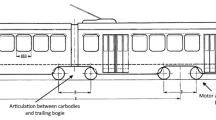Abstract
The basic purpose of a tire is to enhance vehicle performances such as driving performance, rolling resistance, durability, ride comfort, noise, wear resistance, etc. by acting as a flexible cushion. To meet the demand for increased vehicle performances, the design method of a tire has advanced. This study proposes a structural design method for tire contour by considering both the tread contour and the sidewall contour, simultaneously. Existing studies of tire contour optimization have focused on the tread contour and the sidewall, separately. Durability, maneuverability and ride comfort are performances that are commonly investigated in tire contour design. Durability, maneuverability and ride comfort can be measured by the values of the strain energy density, tension and vertical stiffness, respectively. The optimization technique using a metamodel is introduced to maximize durability while satisfying the imposed constraints of tension and ride comfort. To achieve this, the responses defined in the optimization formulation are expressed mathematically in explicit form with respect to the design variables by using the kriging surrogate model, resulting in a simple optimization problem. Then, the simulated annealing algorithm is utilized to find the global optimum.
Similar content being viewed by others
References
S. J. Lee and C. Y. Shon, Navigating of EU Environment Regulation for Tire, Auto journal, Journal of KSAE, 31(6) (2009) 16–27.
H. W. Kim, T. Kim, J. G. Cho and S. S. Mun, Tire Engineering, Goldenbell (2004) 39–45.
R. B. Day and S. D. Gehman, Theory for the meridian Section of Inflated Cord Tires, Rubber Chemistry and Technology, 36 (1963) 11.
K. Yamagishi, M. Togashi, S. Furuya, K. Tsukahara and N. Yoshimura, A Study on the Contour of the Radial Tire:Rolling Contour Optimization Theory-(RCOT), Tire Science and Technology, TSTCA 15(1) (1987) 3–29.
J. R. Cho, S. W. Shin and W. S. Yoo, Crown Shape Optimization for Enhancing Tire Wear Performance by ANN, Computers & Structures, 83(12–13) (2005) 920–933.
G. Unnithan, R. KrishanKumar and A. Prasad, Application of a Shell-Spring Model for the Optimization of Radial Tire Contour Using a Genetic Algorithm, Tire Science and Technology, TSTCA 31(1) (2003) 39–63.
W. Yang and Y. Cheng, CAD/CAE and Optimization Design of Radial Tire, Symposium of International Rubber Conference (2004) 15–18.
X. Ren and Z. Yao, Structure Optimization of Pneumatic Tire Using an Artificial Neural Network, Lecture Notes in Computer Science (Advanced in Neural Network-ISSN 2004) 3174 (2004) 15–18.
Y. Nakajima, T. Kamegawa and K. Ueno, Application of a Neural Network for the Optimization of Tire Design, Tire Science and Technology, 27(2) (1999) 62–83.
J. R. Cho, H. S. Jeong, H. W. Kim and K. W. Kim, Optimal Design of Tire Sidewall Contour for Improving Maneuverability and Durability, Transactions of KSME, 25(10) (2001) 1636–1643.
A. Guinta and L. Watson, A comparison of approximation modeling techniques: polynomial versus interpolation models. Proceedings of the 7th AIAA/USAF/NASA/ISSMO Symposium on Multidisciplinary Analysis and Optimization, St. Louis, MO, USA, 2 (1998) 392–440.
K. T. Fang, R. Li and A. Sudjianto, Design and modeling for computer experiments, (Chapman & Hall/CRC, London) (2006).
K. H. Lee and D. H. Kang, Structural Optimization of an Automotive Door Using the Kriging Interpolation Method, Journal of Automobile Engineering, 221(12) (2007) 1525–1534.
H. C. Park and H. W. Shim, Car, Tire and Durability of Tire, Journal of KSAE, 25(3) (2003) 21–22.
J. Hwang and S. Namgung, A Study on the Design of Automotive Tire Profile for High Speed Durability Improvement, Journal of the KSPE, 14(12) (1997) 135–136.
S. R. Kim, K. D. Sung and C. T. Cho, A Study in the Belt Width and Separation of Tire using FEM, Journal of the KSPE, 23(8) (2006) 137–144.
Y. H. Han, B. B. Eric, E. P. Fahrenthold and D. M. Kim, Fatigue Life Prediction for Cord-Rubber Composite Tire Using a Global-Local Finite Element Method, Tire Science and Technology, TSTCA 32(1) (2004) 24–27.
X. Yan, Y. Wang and X. Feng, Study for the endurance of radial truck tires with finite element modeling, Mathematics and Computers in Simulation, 59 (2002) 471–488.
H. S. Heo, J. S. Shim and W. H. Shon, Experimental Comparative Analysis and Subjective Evaluation on the Handling Stability Characteristics of Passenger Cars, Journal of KSAE, 3(4) (1995) 30–40.
Abaqus Standard User’s Manual, Version 6.8, Abaqus Inc.
H. G. Kwak and H. J. Kim, An Introduction to Computer Aided Engineering of Tire, Auto Journal of KSAE, 31(3) (2009) 47–53.
Author information
Authors and Affiliations
Corresponding author
Additional information
This paper was recommended for publication in revised form by Associate Editor Jeonghoon Yoo
D. W. Lee is a visiting professor of Mechanical Engineering at Dong-A University, Busan, South Korea. He earned his B.S. in Mechanical Engineering degree in 1995, and his Ph.D. in 2003, from Dong-A University. His research interest lies in optimum design and fatigue.
K. H. Lee is an associate professor of Mechanical Engineering at Dong-A University, Busan, South Korea, where he has taught and conducted numerous research studies since 2002. He earned his B.S. in Mechanical Engineering degree in 1989, and his Ph.D. in 1997, from Hanyang University. He is currently working on developing a robust design methodology.
Rights and permissions
About this article
Cite this article
Lee, D.W., Kim, J.K., Kim, S.R. et al. Shape design of a tire contour based on approximation model. J Mech Sci Technol 25, 149–155 (2011). https://doi.org/10.1007/s12206-010-1108-7
Received:
Revised:
Accepted:
Published:
Issue Date:
DOI: https://doi.org/10.1007/s12206-010-1108-7




